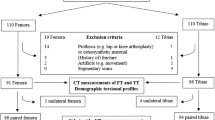Summary.
In the treatment of femoral and tibial fractures the frontal and sagittal planes are controlled and documented by conventional X-ray films. Computed tomography permits exact measurement of the coronal plane. Between June 1993 and December 1997, 161 computed tomographic measurements of femoral torsion and 55 of tibial torsion after shaft fracture were carried out. The results were analyzed in a clinical study. A CT examination was carried out if the clinical examination aroused suspicion of a difference in torsion. 28.5 % of the patients examined with femoral fractures and 23.8 % of those with tibial fractures had torsion differences of more than 20 °. Between June 1993 and June 1997, 30 corrective derotating osteotomies of the femur and 9 of the tibia were carried out.The average preoperative difference of torsion of the femur was 29 ° and of the tibia 25 °. After the operation the average femur difference was 7 ° and of the lower leg 6.5 °, which are inside normal physiological limits. The osteotomies were carried out in the metaphysis near the fracture. Additional corrections in other planes were necessary on the femur in 27 % and on the lower leg in 46 %. With the aim of avoiding torsion differences, or at least to recognize them at an early stage, CT measurements of torsion after osteosythetic treatment of fresh unilateral femur-shaft fractures were carried out in 49 patients between October 1996 and December 1997. The torsion measurements during the operations had to be carried out clinically. No sufficiently exact method of measurement is available in the operating room. Three patients with increased differences of 28 °, 26 ° or 19 ° had their osteosyntheses corrected. The measurements after correction were inside the normal spread.
Zusammenfassung.
Die Achsstellung nach Versorgung von Ober- und Unterschenkelfrakturen in der Frontal- und Sagittalebene wird im konventionellen Röntgenbild kontrolliert und dokumentiert. In der Horizontalebene ist eine genaue Bestimmung nur mit der Computertomographie möglich. In einer klinischen Studie wurden zwischen Juni 1993 und Dezember 1997 200 computertomographische Torsionsmessungen am Ober- und 80 am Unterschenkel nach Schaftfrakturen analysiert. Die Messungen erfolgten beim klinischen Verdacht auf das Vorliegen einer Torsionswinkeldifferenz. Am Oberschenkel wurden in 28,5 %, am Unterschenkel in 23,8 % aller untersuchten Patienten Torsionsdifferenzen von mehr als 20 ° festgestellt. Zwischen Juni 1993 und Juni 1997 wurden 30 derotierende Korrekturosteotomien am Femur und 9 an der Tibia vorgenommen. Die Torsionsdifferenz betrug am Oberschenkel präoperativ durchschnittlich 29,0 ° und am Unterschenkel 25,0 °. Die postoperativen Differenzen lagen am Oberschenkel durchschnittlich bei 7 °, am Unterschenkel durchschnittlich bei 6,5 ° und damit innerhalb der physiologischen Schwankungsbreite. Die Osteotomien erfolgten jeweils in den frakturnahen Metaphysen. Zusätzliche Korrekturen in anderen Ebenen erfolgten am Femur in 27 % und am Unterschenkel in 46 %. Mit dem Ziel, Torsionsdifferenzen zu vermeiden oder zumindest frühzeitig zu erkennen, erfolgte ab Oktober 1996 bei 49 Patienten die computertomographische Torsionsmessung nach osteosynthetischer Versorgung einer frischen unilateralen Femurschaftfraktur. Die Torsionsbestimmung erfolgte intraoperativ jeweils klinisch, da im Operationssaal eine apparative Meßmethode mit hinreichender Genauigkeit nicht zur Verfügung steht. Bei 3 Patienten mit relevanten Differenzen (28 °, 26 ° und 19 °) erfolgte die Korrektur der Osteosynthese. Die Messungen nach Korrektur waren im Bereich der Normalverteilung.
Similar content being viewed by others
Author information
Authors and Affiliations
Rights and permissions
About this article
Cite this article
Grützner, P., Hochstein, P., Simon, R. et al. Torsionswinkelbestimmung nach Schaftfrakturen der unteren Extremität – klinische Relevanz und Meßmethoden. Chirurg 70, 276–284 (1999). https://doi.org/10.1007/s001040050643
Issue Date:
DOI: https://doi.org/10.1007/s001040050643




